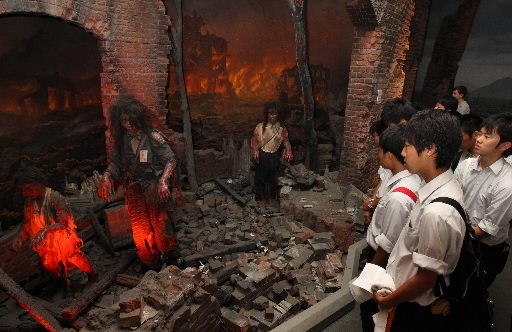Debate over removal of Peace Museum’s mannequins
Jun. 10, 2013
Priority on real artifacts: Opportunity to consider how to convey A-bomb tragedy
by Michiko Tanaka, Staff Writer
A controversy has emerged over the Hiroshima City Government’s decision to remove the plastic mannequins that depict A-bomb victims from Hiroshima Peace Memorial Museum. The change is to be made in connection with a major renovation of the museum’s exhibition content. Signatures of people calling for retraction of that decision were submitted on June 6. As the aging of survivors makes it increasingly difficult to pass on the A-bomb experiences, this debate over the plastic figures highlights the question of how the museum should convey the message of Hiroshima.
Akihiro Katsube, a resident of Saeki Ward, visited the museum on June 6 and submitted the signatures of 1,700 people to Noriyuki Masuda, deputy director of the museum. Speaking to Mr. Masuda, Mr. Katsube said, “I have been alarmed by the decision to remove the mannequins. Life-size mannequins are indispensable to conveying the reality of the atomic bombing.”
The city government announced the decision to remove the mannequins to the municipal assembly in mid-March. Since then, the city has received a total of about 200 telephone calls and text messages opposing that decision. In late March Mr. Katsube started collecting through the Internet signatures protesting the city’s decision.
The three mannequins are displayed in the main building of the museum near its entrance. They show how people fled through the debris to escape from fires caused by the atomic bombing. Many children quickly avert their eyes from the mannequins with skin dangling from arms raised in front of their bodies.
The current figures were installed in 1991 and are the second generation. The first generation of wax figures were put on display in 1973. At the time, many objected to the displaying of “fakes;” some members of the City Council said that mannequins are mere fakes no matter how realistic they are made to look.
A-bomb survivors oppose removal
The planned removal of the plastic figures met with mixed reactions from A-bomb survivors. Hiromu Morishita, 82, the former chairman of the NPO World Friendship Center opposes removal. This former high school teacher said, “The figures help visitors imagine what victims experienced. They are an important display, though some children might be shocked.”
Sunao Tsuboi, 88, chair of the Hiroshima Prefectural Confederation of A-bomb Sufferers Organization, said “The mannequins now on display are not good enough. The reality was far more appalling. If the figures are to be kept, why not display more figures and show the misery of the atomic bombing more realistically?”
Why has the city decided to remove the mannequins? Deputy Director Masuda said, “Some people believe it is because they frighten children, but that is not the reason.”
The City of Hiroshima started reviewing exhibition content in 2004 in connection with the museum’s planned seismic retrofitting. The basic plan compiled by a committee of experts in 2010 placed the focus on displaying real A-bomb materials that convey the reality directly.
Mr. Masuda said, “I hope to display more personal belongings and photos to accurately convey the reality of the atomic bombing.” He added that, along with the facts, an emphasis will also be on conveying the grief of victims and their families. Part of this effort will be an area for displaying victims’ personal belongings, photographs, and explanations of how they were exposed to the atomic bomb.
In response to the signatures, Mr. Masuda said that he is grateful for the high level of interest demonstrated by citizens, but the decision taken after much discussion must be respected, implying that the decision will not be withdrawn.
Present overall picture
Akiko Naono, an associate professor of sociology at the Graduate School of Kyushu University acknowledged the city’s decision and said, “It’s a good idea to have visitors meet the victims through their belongings. This approach appeals to people’s imagination.” But she also pointed out that the city should present a clear overall picture to help people understand what the city plans to show after the museum is renovated. She also said that the city should hold more discussions and be flexible enough to adopt good ideas.
The museum will undergo extensive renovation starting this fiscal year. The whole renovation will be finished in fiscal 2018. The city government plans to remove the mannequins in fiscal 2016.
With each passing year, the number of people who can recount their A-bomb experiences decreases. How can we convey experiences that are beyond our imagination? How should the museum be designed to present this history? If the mannequins are to be removed, is there any other way to utilize them? Why not seize the opportunity presented by the debate over the mannequins and give careful consideration to these questions?
Keywords
Plan to review the exhibition content of Hiroshima Peace Memorial Museum
In connection with the seismic retrofitting of the main building of Hiroshima Peace Memorial Museum, the city’s committee of experts began discussing exhibition content in 2004. The committee sought public comment and established a basic plan in July 2010. With some changes in membership, the committee compiled a detailed plan in March this year. The plan includes effective display of 200 genuine artifacts, including personal effects of victims. The museum renovation will begin with the East Building from fiscal 2013 to 2015. The main building will be renovated in fiscal 2016 and 2017, and the project will be completed in fiscal 2018.
(Originally published on June 7, 2013)








